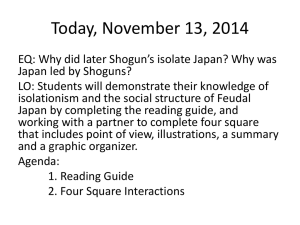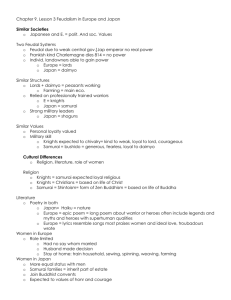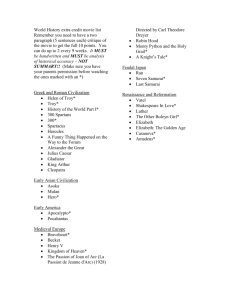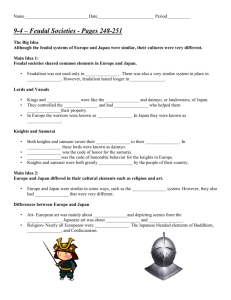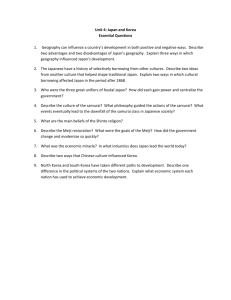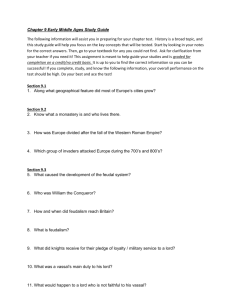The Rise of the Warrior Class in Japan GUIDE TO READING NOTES
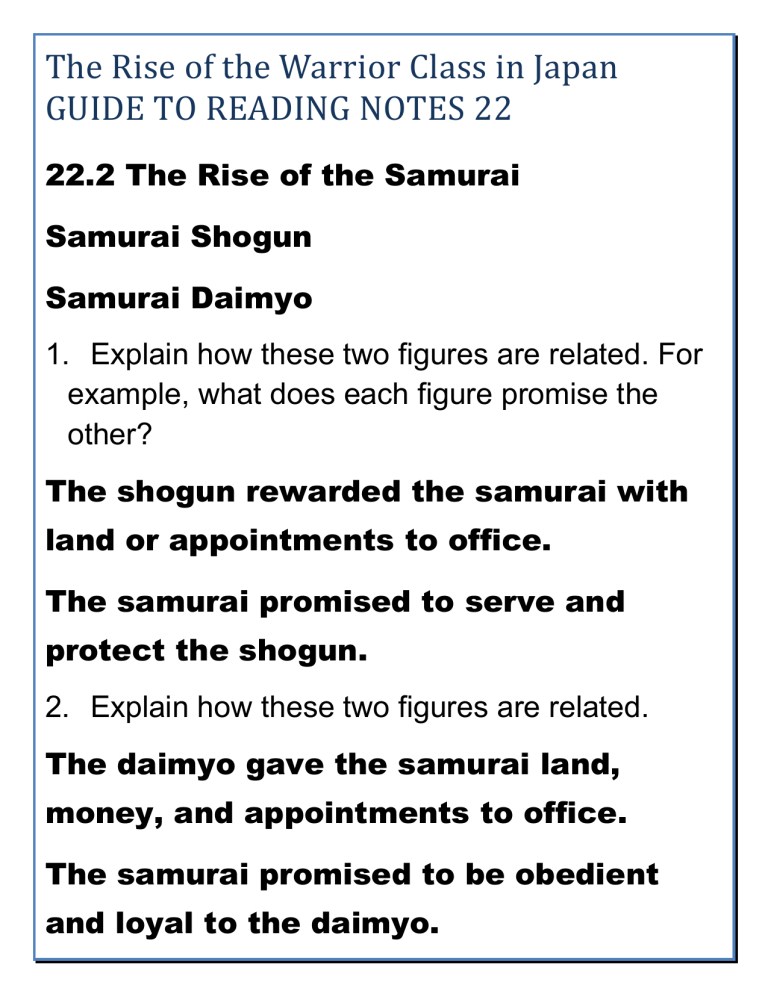
The Rise of the Warrior Class in Japan
GUIDE TO READING NOTES 22
22.2 The Rise of the Samurai
Samurai Shogun
Samurai Daimyo
1. Explain how these two figures are related. For example, what does each figure promise the other?
The shogun rewarded the samurai with land or appointments to office.
The samurai promised to serve and protect the shogun.
2. Explain how these two figures are related.
The daimyo gave the samurai land, money, and appointments to office.
The samurai promised to be obedient and loyal to the daimyo.
22.3 The Samurai’s Armor and Weapons
1. Label three important parts of the samurai’s armor.
2. Label the samurai’s weapon.
3. Add one additional weapon to the drawing.
Label it.
Students might draw and label a
Bow and arrow or
A spear
Sword
Metal sleeves shoulder guards
Shinguards
Iron mask
Helmet
22.4 Military Training and Fighting
1. Write one interesting detail about a samurai’s training in archery.
Samurai learned to shoot accurately while riding horseback.
2. Write one interesting detail about a samurai’s training to use the sword.
Samurai learned how to fight against more than one person at a time.
3. In the voice bubble, write what a samurai might say before a battle.
Answers should include the
Name of the samurai,
His ancestors, His heroic deeds, and his reason for fighting.
22.5 Mental Training
1. In the thought bubble, write what a samurai should think about every day to overcome his fear of death.
I should think of myself as already dead.
2. In the space below, write an example of how samurai were trained to be prepared at all times.
One samurai was hit with a wooden sword throughout the day until he learned to always stay alert.
22.6 Training in Writing and Literature
1. Above the samurai, draw an example of a calligraphy character a samurai might practice.
Students should try to draw a Chinese character.
2. What is haiku?
Haiku is poetry that consists of three lines of five, seven, and five syllables.
22.7 Training for the Tea Ceremony
Around the samurai, draw and label three objects a samurai would see when he attended a tea ceremony.
Drawings might include a tea caddy, a small bowl, a wooden dipper, a whisk, a scroll painting, a flower arrangement, or an urn.
22.8 Training in Spiritual Strength
1. In the thought bubble, write something to show how a samurai would prove his devotion to Amida
Buddha
Amida Buddha, Amida
Buddha, Amida Buddha...
Amida Buddha, Amida
Buddha, Amida Buddha...
2. Sketch a Zen garden below. Label what each item in the garden stands for
The sand stands for the sea, the rocks stand for the islands
3. explain how one can achieve enlightenment according to Zen Buddhism
One can achieve enlightenment through meditation and through giving up logical thinking
22.9 The code of Bushido and Samurai
Values
1. In the thought bubble, write how the samurai believed he should act toward his lord
I am always loyal to my lord
And I am willing to die for him.
2. list at least three reasons a samurai might commit seppuku
1) to preserve personal honor
2) To avoid capture in battle
3) To atone for a crime, shameful deed, or insult to another
4) As a form of protest against an injustice
5) As a punishment for a crime
6) Because of the death of a lord
22.10 Women in Samurai Society
1. Draw a 12th-century samurai woman next to the male samurai.
The size of the woman should show her status in the 12th century as compared to a samurai man at this time.
The drawing might show a woman in a fighting position and the same size as the male samurai.
2. How did the position of samurai women change from the 12th to the 17th century?
Samurai women became completely under the control of men.

